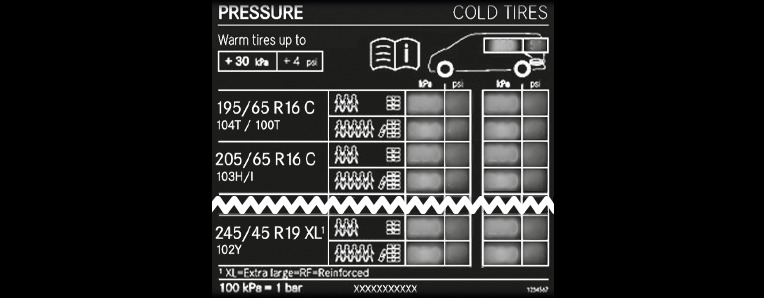
Additionally, the tyre pressure table may also state tyre pressures for different load conditions. These are defined in the tyre pressure information table as different numbers of passengers and amounts of luggage. The actual number of seats may differ – for more information, please refer to the vehicle's registration documents.
The tyre pressure values given for partly laden vehicles are minimum values which offer you good ride comfort.
You can also use the tyre pressure values for a fully laden vehicle. These are always allowed and permissible. However, in a partially laden vehicle, the ride is not as comfortable and energy consumption is only minimally reduced. In addition, wear is greater in the middle of the tyre tread.
Use a suitable pressure gauge to check the tyre pressure. The outer appearance of a tyre does not permit any reliable conclusion about the tyre pressure.
On vehicles fitted with the electronic tyre pressure monitor, the tyre pressure can be checked using the on-board computer.
Set the correct tyre pressure before loading the vehicle. Once the vehicle is laden, check the tyre pressures and correct them if necessary.
The vehicle has been parked with the tyres out of direct sunlight for at least three hours.
The vehicle has travelled less than 1.6 km.
A rise in the tyre temperature of 10°C increases the tyre pressure by approx. 10 kPa (0.1 bar/1.5 psi). Take this into account when checking the tyre pressure of warm tyres.
shorten the service life of the tyres
cause increased tyre damage
have a negative effect on handling characteristics and thus driving safety (e.g. due to aquaplaning)
with a permissible gross vehicle weight of 3500 kg
with a permissible axle load of 1800 kg on the rear axle
with a maximum permissible speed limit of 160 km/h
the tyres referred to under "Wheel and tyre combinations" More
Tyre pressure for the spare wheel is 410 kPa (4.1 bar/59 psi).
Partially laden vehicle | Fully laden vehicle | |||
|---|---|---|---|---|
Tyres/disk wheel | Front axle | Rear axle | Front axle | Rear axle |
245/55 R17 XL | 250 kPa (2.5 bar/36 psi) | 250 kPa (2.5 bar/36 psi) | 270 kPa (2.7 bar/39 psi) | 300 kPa (3.0 bar/44 psi) |
with a permissible gross vehicle weight of 3500 kg
with a permissible axle load of 1750 kg on the rear axle
with a maximum permissible speed limit of 160 km/h
with air suspension
the tyres referred to under "Wheel and tyre combinations" More
Tyre pressure for the spare wheel is 410 kPa (4.1 bar/59 psi).
Partially laden vehicle | Fully laden vehicle | |||
|---|---|---|---|---|
Tyres/disk wheel | Front axle | Rear axle | Front axle | Rear axle |
245/55 R17 XL | 250 kPa (2.5 bar/36 psi) | 250 kPa (2.5 bar/36 psi) | 270 kPa (2.7 bar/39 psi) | 300 kPa (3.0 bar/44 psi) |
245/50 R18 XL | 260 kPa (2.6 bar/38 psi) | 260 kPa (2.6 bar/38 psi) | 280 kPa (2.8 bar/41 psi) | 290 kPa (2.9 bar/42 psi) |

